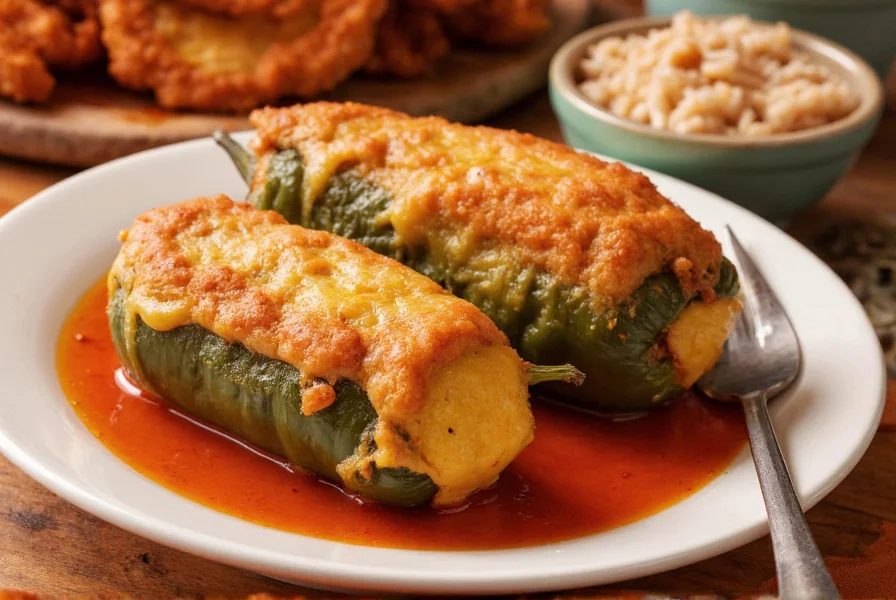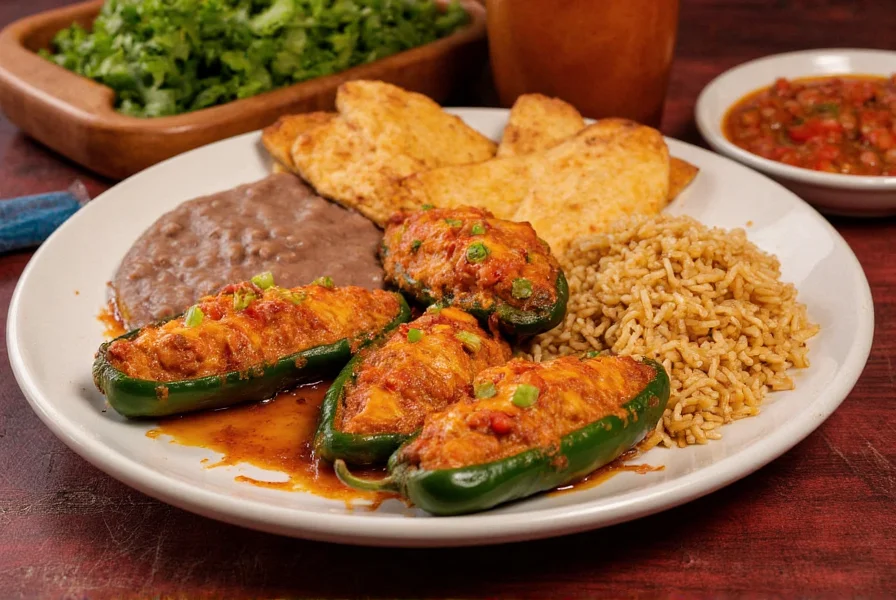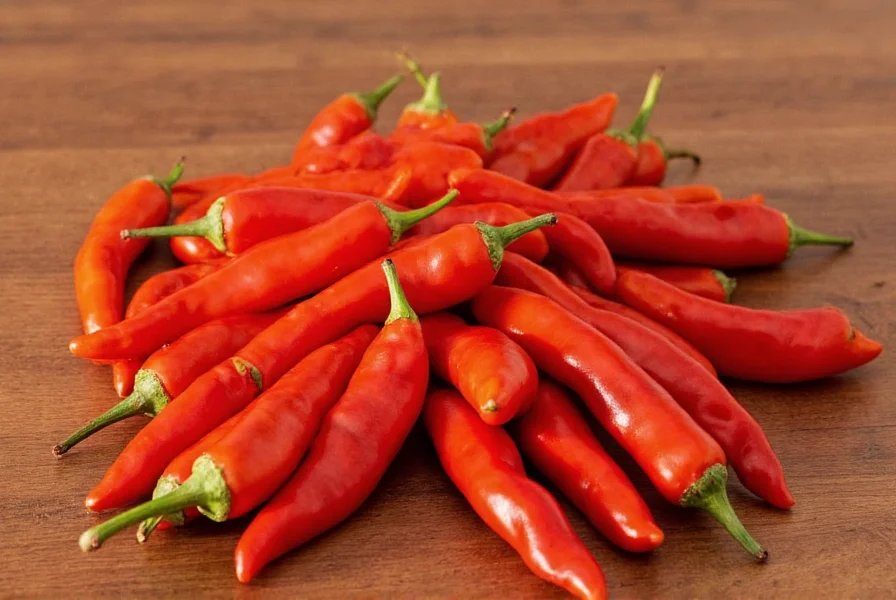| Key Element | Description |
|---|---|
| Primary Pepper | Poblano (fresh, medium heat) |
| Traditional Filling | Queso fresco or Oaxaca cheese |
| Cooking Method | Roasted, stuffed, battered, fried |
| Origin | Mexican (Central Mexico) |
| Heat Level | Mild to medium (depends on pepper) |
 ## The Authentic Preparation Process Creating an authentic chili relleno requires careful attention to several key steps that have been perfected over centuries. First, fresh poblano peppers undergo charring over an open flame or under a broiler until their skins blister and blacken. This roasting process not only enhances flavor but also makes the skin easier to remove. After roasting, the peppers cool briefly before their skins are carefully peeled away. The next crucial step involves delicately removing the seeds and membranes while preserving the pepper's structural integrity—a skill that takes practice to master. The hollowed peppers then receive their cheese filling, traditionally queso fresco for its mild flavor and ability to maintain shape when melted, though Oaxaca cheese has become increasingly popular for its stringy melt. The battered coating represents another distinctive element of authentic chili rellenos. Unlike some Americanized versions that use flour-based batters, traditional recipes call for a light, airy egg batter made by separating the eggs, beating the whites to stiff peaks, then gently folding in the yolks. This creates the signature fluffy exterior that contrasts beautifully with the soft pepper interior. ## Regional Variations Across Mexico While the basic concept remains consistent, chili rellenos showcase remarkable regional diversity throughout Mexico: - **Central Mexico**: The birthplace of the dish features simpler preparations with minimal fillings, focusing on the pepper's natural flavor - **Northern Mexico**: Often includes meat fillings like picadillo (seasoned ground beef) alongside cheese - **Coastal Regions**: May incorporate seafood fillings such as shrimp or crab - **Oaxaca**: Famous for using local Oaxaca cheese and serving with black bean sauce - **Puebla**: Known for incorporating fruit elements like plantains in some variations This regional diversity demonstrates how what is a chili relleno made of can vary significantly depending on local ingredients and culinary traditions. Some versions even feature multiple fillings layered within the pepper, creating complex flavor profiles that reflect Mexico's rich culinary heritage. ## Cultural Significance and Modern Adaptations Chili rellenos hold special significance in Mexican culinary culture, often appearing during celebrations and family gatherings. The dish represents the perfect marriage of indigenous ingredients (the poblano pepper) with European techniques (egg battering and frying introduced by Spanish colonists). In contemporary cuisine, chefs have expanded traditional interpretations while respecting the dish's essence. Modern adaptations include: - Vegetarian versions with vegetable and cheese fillings - Vegan alternatives using plant-based cheeses - Health-conscious preparations with baked rather than fried coatings - Gourmet interpretations featuring specialty cheeses and artisanal ingredients Despite these innovations, the core elements defining what a chili relleno is remain consistent: a roasted pepper, thoughtfully stuffed, and carefully prepared to highlight its unique characteristics. ## How to Enjoy Chili Rellenos Authentically When experiencing chili rellenos as they're meant to be enjoyed, certain serving traditions enhance the experience. Traditional accompaniments include: - Fresh tomato salsa or ranchero sauce - Mexican rice - Refried beans - A simple green salad with lime dressing The ideal chili relleno should present a beautiful contrast between the slightly crisp, golden exterior and the tender, flavorful interior. When cut open, the melted cheese should flow gently from the roasted pepper, creating a visually appealing presentation that signals proper preparation.
## The Authentic Preparation Process Creating an authentic chili relleno requires careful attention to several key steps that have been perfected over centuries. First, fresh poblano peppers undergo charring over an open flame or under a broiler until their skins blister and blacken. This roasting process not only enhances flavor but also makes the skin easier to remove. After roasting, the peppers cool briefly before their skins are carefully peeled away. The next crucial step involves delicately removing the seeds and membranes while preserving the pepper's structural integrity—a skill that takes practice to master. The hollowed peppers then receive their cheese filling, traditionally queso fresco for its mild flavor and ability to maintain shape when melted, though Oaxaca cheese has become increasingly popular for its stringy melt. The battered coating represents another distinctive element of authentic chili rellenos. Unlike some Americanized versions that use flour-based batters, traditional recipes call for a light, airy egg batter made by separating the eggs, beating the whites to stiff peaks, then gently folding in the yolks. This creates the signature fluffy exterior that contrasts beautifully with the soft pepper interior. ## Regional Variations Across Mexico While the basic concept remains consistent, chili rellenos showcase remarkable regional diversity throughout Mexico: - **Central Mexico**: The birthplace of the dish features simpler preparations with minimal fillings, focusing on the pepper's natural flavor - **Northern Mexico**: Often includes meat fillings like picadillo (seasoned ground beef) alongside cheese - **Coastal Regions**: May incorporate seafood fillings such as shrimp or crab - **Oaxaca**: Famous for using local Oaxaca cheese and serving with black bean sauce - **Puebla**: Known for incorporating fruit elements like plantains in some variations This regional diversity demonstrates how what is a chili relleno made of can vary significantly depending on local ingredients and culinary traditions. Some versions even feature multiple fillings layered within the pepper, creating complex flavor profiles that reflect Mexico's rich culinary heritage. ## Cultural Significance and Modern Adaptations Chili rellenos hold special significance in Mexican culinary culture, often appearing during celebrations and family gatherings. The dish represents the perfect marriage of indigenous ingredients (the poblano pepper) with European techniques (egg battering and frying introduced by Spanish colonists). In contemporary cuisine, chefs have expanded traditional interpretations while respecting the dish's essence. Modern adaptations include: - Vegetarian versions with vegetable and cheese fillings - Vegan alternatives using plant-based cheeses - Health-conscious preparations with baked rather than fried coatings - Gourmet interpretations featuring specialty cheeses and artisanal ingredients Despite these innovations, the core elements defining what a chili relleno is remain consistent: a roasted pepper, thoughtfully stuffed, and carefully prepared to highlight its unique characteristics. ## How to Enjoy Chili Rellenos Authentically When experiencing chili rellenos as they're meant to be enjoyed, certain serving traditions enhance the experience. Traditional accompaniments include: - Fresh tomato salsa or ranchero sauce - Mexican rice - Refried beans - A simple green salad with lime dressing The ideal chili relleno should present a beautiful contrast between the slightly crisp, golden exterior and the tender, flavorful interior. When cut open, the melted cheese should flow gently from the roasted pepper, creating a visually appealing presentation that signals proper preparation.
 ## Understanding the Difference: Chili Relleno vs. Chile Poblano Many people confuse chili rellenos with chile poblanos, but understanding what is a chili relleno meaning in English helps clarify this distinction. A chile poblano refers specifically to the type of pepper used—large, dark green, heart-shaped peppers with mild to medium heat. A chili relleno, by contrast, describes the preparation method: a stuffed and battered poblano pepper. This distinction matters when exploring authentic Mexican cuisine, as menus might list "chiles rellenos" (plural form) to indicate the dish, while "chile poblano" refers to the ingredient itself. Recognizing this difference helps diners understand menu offerings and communicate their preferences accurately. ## Preserving Tradition in Modern Kitchens As home cooks and professional chefs alike continue to explore traditional Mexican cuisine, maintaining the integrity of dishes like chili rellenos becomes increasingly important. The growing popularity of authentic preparations has led to greater availability of key ingredients like fresh poblanos and traditional Mexican cheeses in international markets. When preparing chili rellenos at home, attention to detail makes all the difference. Selecting perfectly ripe poblanos, properly roasting and peeling them without damaging their structure, creating the ideal cheese-to-pepper ratio, and achieving the perfect light batter all contribute to an authentic experience that honors the dish's rich heritage.
## Understanding the Difference: Chili Relleno vs. Chile Poblano Many people confuse chili rellenos with chile poblanos, but understanding what is a chili relleno meaning in English helps clarify this distinction. A chile poblano refers specifically to the type of pepper used—large, dark green, heart-shaped peppers with mild to medium heat. A chili relleno, by contrast, describes the preparation method: a stuffed and battered poblano pepper. This distinction matters when exploring authentic Mexican cuisine, as menus might list "chiles rellenos" (plural form) to indicate the dish, while "chile poblano" refers to the ingredient itself. Recognizing this difference helps diners understand menu offerings and communicate their preferences accurately. ## Preserving Tradition in Modern Kitchens As home cooks and professional chefs alike continue to explore traditional Mexican cuisine, maintaining the integrity of dishes like chili rellenos becomes increasingly important. The growing popularity of authentic preparations has led to greater availability of key ingredients like fresh poblanos and traditional Mexican cheeses in international markets. When preparing chili rellenos at home, attention to detail makes all the difference. Selecting perfectly ripe poblanos, properly roasting and peeling them without damaging their structure, creating the ideal cheese-to-pepper ratio, and achieving the perfect light batter all contribute to an authentic experience that honors the dish's rich heritage.
What is the difference between a chili relleno and a jalapeño popper?
While both involve stuffed peppers, chili rellenos traditionally use larger poblano peppers with mild heat, are battered with egg rather than breaded, and feature cheese as the primary filling without additional meats or spices common in jalapeño poppers, which use smaller, hotter jalapeños.
Are chili rellenos always spicy?
No, authentic chili rellenos made with poblano peppers are typically mild to medium in heat. Poblanos range from 1,000-2,000 Scoville units, making them significantly milder than jalapeños. The heat level can be further controlled by removing all seeds and membranes during preparation.
What's the best cheese for traditional chili rellenos?
Queso fresco is the traditional choice for authentic chili rellenos as it maintains its shape when melted. Oaxaca cheese has become increasingly popular for its stringy melt and mild flavor. Both cheeses complement the poblano pepper without overpowering its distinctive taste.
Can chili rellenos be made ahead of time?
Yes, prepared but unbattered peppers can be refrigerated for up to 24 hours. For best results, stuff the peppers, wrap them individually in plastic, and store in an airtight container. Complete the battering and frying just before serving to maintain the ideal texture contrast between the crispy exterior and tender interior.
What's the origin of the name 'chili relleno'?
'Chili relleno' translates to 'stuffed pepper' in English. 'Chili' refers to the pepper (specifically the poblano in this dish), while 'relleno' comes from the Spanish verb 'rellenar,' meaning 'to stuff' or 'to fill.' The name perfectly describes this traditional Mexican preparation method.











 浙公网安备
33010002000092号
浙公网安备
33010002000092号 浙B2-20120091-4
浙B2-20120091-4